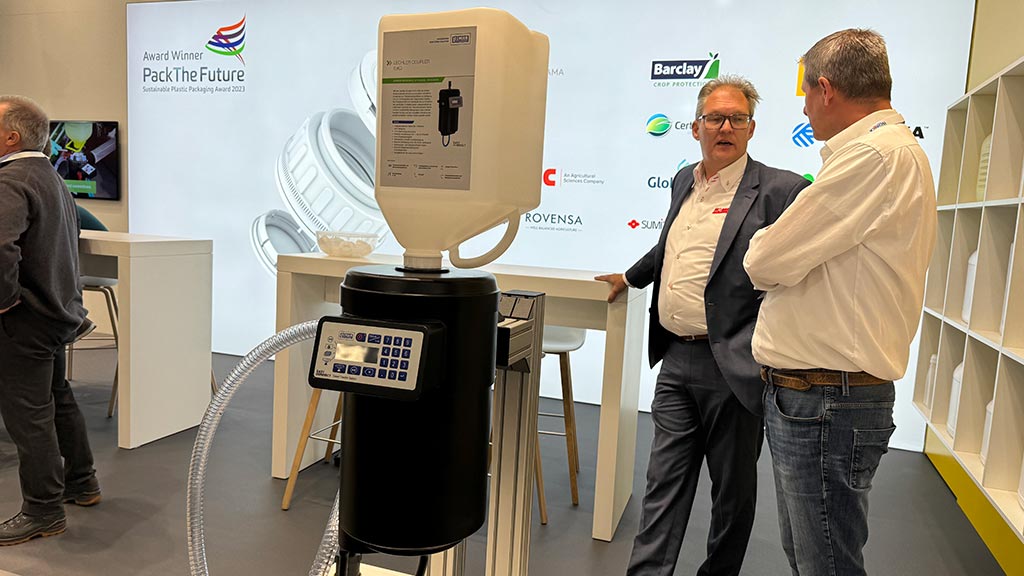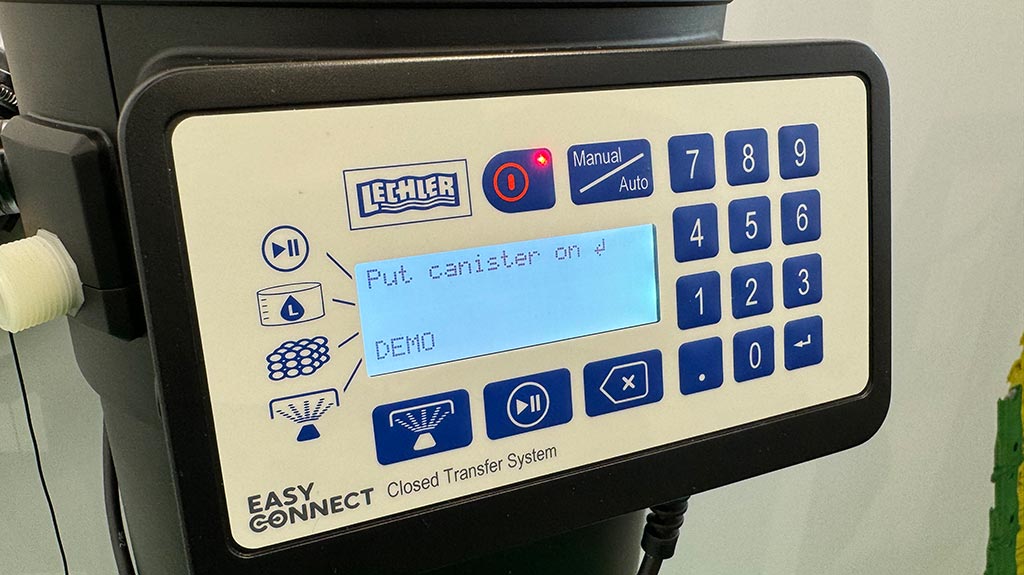Lechler showcases new closed-transfer sprayer coupling
 © Adam Clarke
© Adam Clarke German spray technology specialist Lechler revealed its new Coupler (LeC) for closed pesticide transfer at this month’s Agritechnica event in Hanover.
EasyConnect is a closed transfer system (CTS) for liquid plant protection products, designed to minimise operator exposure and point-source pollution when transferring chemicals from container to sprayer tank ahead of application.
The system combines two elements. The first is the EasyConnect cap, which is pre-fitted to chemical cans – its design having been adopted as standard by all major agrochemical manufacturers involved with the EasyConnect Working Group.
See also: Contractors build blackgrass-beating 24m weed wiper
The second is the coupler, which is the engineering solution that enables the can’s contents to be drawn out of the cap’s clever valve design.
There are now a handful of options available to sprayer operators when choosing a coupler to use with the EasyConnect cap.
All of them allow containers to be fully emptied and rinsed out, or partially emptied and the contaminated components cleansed.
Some are manual, like the Pentair Cleanload Nexus, with the operator controlling the locking, extraction, rinsing and unlocking processes from start to finish with a lever and flow valves.
Fully automatic
Lechler’s new Coupler joins Israeli firm Tefen’s AccuRite in offering a fully automatic electronic system, which is programmed from a digital keypad and display on the front of the cylinder.
The operator presses a button when the can is offered up, prompting the LeC to lock on and insert its probe.
It’s then possible to manually select complete emptying, or let the system automatically extract a pre-selected quantity if only using a part can.
The cleaning process is subsequently triggered, before the clean empty can (or part can with clean EasyConnect cap) is released.
Lechler development engineer Hannes Knupfer told Farmers Weekly that the kit needs three connections to run.
These include a 12V electric supply, suction to draw out the chemical – typically from the sprayer’s venturi system – and a pressurised water line running at about 6bar.
The equipment can be fitted to the sprayer itself, on a wall in a fill-up area, or on a trolley if mobility is required, although Hannes believes the latter two are the best options, where practicable.
“With manual or electronic systems, vibrations will kill everything faster, and the life expectancy could be shorter [where fitted to the sprayer].”
He added that the unit is bigger than others on the market because Lechler wanted to enclose everything in one outer housing.
This is designed to keep all the electrics clean and allows the operator to safely hose it down with a jet wash after working in wet and muddy conditions.

© Adam Clarke
Accurate dosing
A key point of difference on the LeC relative to the other automatic coupler, the AccuRite, is the way it measures part doses.
Rather than the flow meter used in the Tefen design, it has a weighing system that comprises three load cells with vibration compensation, which Lechler claims is much more accurate.
It does require the operator to enter the density of the liquid product, which is found as a g/cu m value on a product’s safety data sheet.
This might be seen as an inconvenience during the filling process, but Hannes says agrochemical manufacturers are open to printing a QR code on product labels, which will provide the necessary information quickly and easily.
The unit will enter commercial testing through 2024, with the first units likely to be sold in 2025.
While there was no concrete price at the time of writing, it’s expected to cost about €3,300-€3,500 (£2,800-£3,000), including the hose and power cable kit.
New liquid fertiliser nozzles improve accuracy
Lechler has added a more flexible liquid fertiliser nozzle option to its range, promising a higher work rate without changing nozzles, plus a longer working life.
The variable flow rate VR range includes the VR-M and VR-L, which, between them, cover the output ranges of five older FD nozzles the design is based on.
This brings Lechler up to speed with competitors, which already offer variable flow rate nozzles suitable for applications where forward speeds vary significantly, or where farms have adopted variable-rate fertiliser.
The firm’s offering differs in its spring-loaded stainless-steel insert – the component that facilitates a variable range of iso sizes in one nozzle – which is claimed to offer a longer working life than more typical rubber insert.
Each nozzle has a list price of €28 (£24), though buyers can expect some wriggle room when negotiating a set from a local distributor.
Border nozzle
As well as the variable-flow addition, liquid fertiliser users can benefit from the Stuttgart-based firm’s new FB border nozzle compatible with its FD-series tips.
Fitted on the end of the right-hand boom, it provides 100% coverage right up to the field edge, minimising any yield or quality drop from “hunger stripes” seen with granular applications.
It also prevents over- or underdosing, or overspraying of the field boundary, if using standard liquid fertiliser nozzles across the boom, reducing waste and the environmental impact.
An electric border nozzle kit is available to switch the border nozzle on and off without leaving the cab.
The FD nozzle immediately inside the border nozzle also needs to be switched off to avoid overspraying.
The FB is available now and costs €20 (£17), with an electric border nozzle kit an extra €337 (£295).

